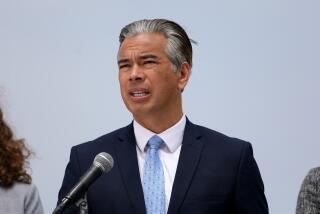Firms to Begin Defense in Lockheed Suit : Courts: The first witness for oil and chemical companies, which are denying worker claims, is expected this week.
Some of the country’s biggest oil and chemical firms this week will begin their defense in the long-running trial of a suit by former Lockheed Corp. workers who claim that they were injured by exposure to toxic chemicals while building fighter jets in Burbank during the 1970s and ‘80s.
Attorneys for the workers, who have called dozens of former workers and expert witnesses to the stand since the trial began in August in Los Angeles Superior Court, are expected to rest today. Lawyers for the 25 defendants, who are expected to call their first witness today or Tuesday, said their case will last up to two months.
Some 624 former Lockheed workers are seeking unspecified damages from the companies that allegedly supplied chemicals and other materials used to make the radar-evading Stealth fighter and other military aircraft. The suit contends that some workers have suffered ailments ranging from skin rashes and memory loss to cancer, and that all face a heightened risk of future illness because of the companies’ failures to provide adequate warnings about the dangers of their products.
The chemical suppliers have denied the claims.
The case has produced some big numbers apart from its many plaintiffs and defendants. Now entering its fifth month, the trial is the longest ever for some of the lawyers. Judge Melvin B. Grover also said it is his longest trial in a decade on the bench.
The trial has brought together more attorneys than practice in some towns. On a recent day, 18 lawyers were in the courtroom--14 on the defense side and four for the workers.
Despite its length and complexity, the trial only directly involves 15 of the 624 workers--a representative group selected by lawyers from both sides. The outcome is expected to trigger settlements with many of the remaining plaintiffs, but more trials could follow.
Some of the defendants are expected to seek dismissal today or Tuesday on grounds that it has not been proven that their products were even used by Lockheed.
If the case continues and goes to the jury, the seven women and five men face the daunting task of deciding whether to award damages in each of the 15 cases. If liability is found, jurors must also decide how much each of the 25 defendants should pay.
For both sides, the potential stakes are huge. If they win, the workers collectively could receive millions of dollars in damages. And, the impact on the companies could extend far beyond this case because most of their chemicals are common in industry and even household products.
The workers say the chemical firms failed to provide adequate information to Lockheed about health risks and safety precautions.
The workers “were the sacrificial lambs,” said Thomas V. Girardi, lead attorney for the plaintiffs. “The inhuman aspect of this case, in my opinion, was massive.”
The defendants claim, however, that workers mostly suffered just temporary ailments, such as skin irritation, and that Lockheed is to blame for any harm that occurred.
“Lockheed provided no safety training on the proper use of chemicals in the workplace,” said Laurence F. Janssen, attorney for eight defendants, including Exxon, Shell, Unocal, DuPont and Arco Chemical Co.
Whether warnings furnished by the companies were adequate is almost beside the point, said Gary T. Drummond, another defense lawyer, because “those things went into a locked drawer at Lockheed.”
Drummond said he was unaware of any previous case “that has involved longtime chemical use in a particular plant, where virtually the entire work force is coming forward and saying, ‘We’ve been injured.’ ”
Lockheed originally was a defendant. But, without admitting liability, the aerospace giant agreed June 30 to pay millions of dollars to workers in exchange for dismissal of the lawsuits and companion worker-compensation claims. At Lockheed’s insistence, the exact settlement amount has not been disclosed. A handful of other defendants also paid settlements and were dismissed from the case.
Lockheed agreed in 1989 to pay a large settlement to the U. S. Occupational Safety and Health Administration for alleged violations at its Burbank production complex. It paid a fine of $1.5 million--then the second-largest fine ever levied by the federal job safety agency--for hundreds of safety lapses, many involving handling of chemicals. Lockheed settlement in that case also was made without admitting liability.
Drummond said the chemical suppliers, in a sense, are not merely defending this one lawsuit but “a whole product line.”
Although Lockheed workers handled asbestos-containing adhesives and certain exotic chemicals, they were mainly exposed to familiar solvents such as xylene, toluene, methyl ethyl ketone and methylene chloride--chemicals that also are used by countless other industries and even in household cleaners, paints and thinners.
“I think the implications are very large,” Drummond said, “because literally . . . oceans of solvents are used yearly in the United States.” He said the manufacturers are defending products “they sell by the tons and the tank cars throughout the United States, that are the backbone of the economy.”
Janssen said chemical firms also fear a plague of similar claims by idled aerospace workers who may look to the companies’ deep pockets to ease their financial distress.
“Given the situation in the aerospace industry in California, the manufacturers of the chemicals are vulnerable because, if you’ve been reading the papers, you know tens of thousands of aerospace workers are being laid off,” he said.
Although no figures were available, the case has surely cost defendants the most, although the plaintiffs also have spent a fortune. Girardi said that all 17 lawyers in his firm, Girardi & Keese, have been involved and that expert witness fees alone have cost the plaintiffs $2 million.
Girardi’s final expert testified last week that the Lockheed workers “more likely than not” have an increased risk of contracting cancer in the future as a result of their exposures.
Dr. Rodger L. Bick, medical director of oncology and hematology at Presbyterian Comprehensive Cancer Center in Dallas, said he reached that opinion by reviewing medical records of four former workers, including one who had died of lung cancer.
Bick said he believed that the workers generally bear a heightened cancer risk because of the materials they handled, although he acknowledged that he had seen no data on actual exposures.
On cross-examination, defense lawyers tried to assail the credibility of the deeply tanned and nearly unflappable Bick. They noted that Bick had testified on behalf of R. J. Reynolds in a smoker death case and attacked Bick’s assertion that a Lockheed worker who smoked a pack a day for at least 37 years had a “rather minimal . . . smoking history.”
Defense lawyers also elicited the fact that Bick was charging $600 per hour, prompting Girardi to quip sarcastically: “All of the defense lawyers donated their time.”
More to Read
Inside the business of entertainment
The Wide Shot brings you news, analysis and insights on everything from streaming wars to production — and what it all means for the future.
You may occasionally receive promotional content from the Los Angeles Times.










